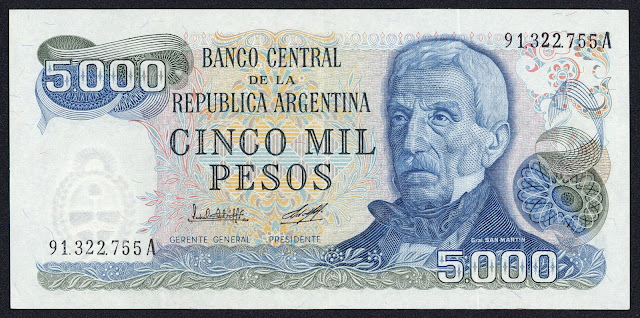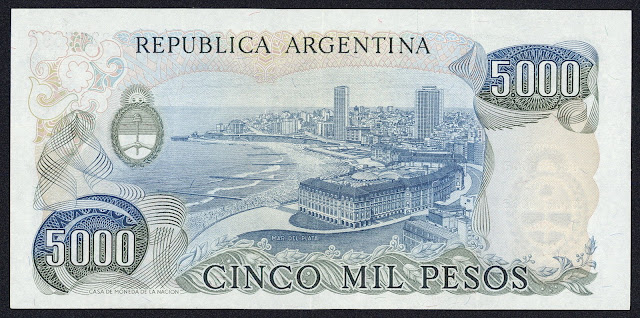Argentina Banknotes 5000 Pesos banknote 1980 General Jose de San Martin
Central Bank of Argentina - Banco Central de la República Argentina
Obverse: Portrait of General Don Jose de San Martin (1778 – 1850), known simply as José de San Martín, was an Argentine general and the prime leader of the southern part of South America's successful struggle for independence from the Spanish Empire.
Reverse: The Famous Mar del Plata Beach Resort with an extensive coastline running along the Atlantic Ocean. Coat of arms of Argentina at left.
Watermark: Coat of arms of Argentina.
Original Size: 150 x 76 mm.
Printer: Casa de Moneda de la Nación, Buenos Aires, Argentina.
Argentina Banknotes - Argentina paper money
1970-1983
500 Pesos 1000 Pesos 5000 Pesos 10000 Pesos
Mar del Plata
Mar del Plata is an Argentine city on the coast of the Atlantic Ocean, 400 km (249 mi) south of Buenos Aires. Mar del Plata is the second largest city of Buenos Aires Province. The name "Mar del Plata" has the meaning of "sea of the Plate region" or "adjoining sea to the (River) Plate region". Mar del Plata is one of the major fishing ports and the biggest seaside beach resort in Argentina. With a population of 614,350 as per the 2010 census [INDEC], it is the 7th largest city in Argentina.
As part of the Argentine recreational coast, tourism is Mar del Plata's main economic activity with seven million tourists visiting the city in 2006. Mar del Plata has a sophisticated tourist infrastructure with numerous hotels, restaurants, casinos, theatres and other tourist attractions. Mar del Plata is also an important sports centre with a multi-purpose Olympic style stadium (first used for the 1978 World Cup and later upgraded for the 1995 Pan American Games), five golf courses and many other facilities.
As an important fishing port, industry concentrates on fish processing and at least two large shipyards.
The area is also host to other light industry, such as textile, food manufacturing and polymers. There is a well-developed packaging machines industry, its quality being recognized in international markets. One of these companies was one of the pioneers in the automatic packaging of tea bags, exporting its original machine-designs abroad. Another company also exports its products and sold royalties to other countries.
During the mid-1980s, Mar del Plata saw the birth of electronics factories, focused mostly on the telecommunications field, with two of them succeeding in the international market.
Since the 2000s, a local company builds and develops oil industry equipment, with customers in the United States, Russia, Oman and Egypt.
Located southwest of the city there are quartzite quarries. The stone is traditionally used in construction. There is a huge area of farms in the rural areas surrounding the city, specialized mostly in the cultivation of vegetables.
Although the area had suffered from a high rate of unemployment from 1995 to 2003, Mar del Plata has seen 46,000 new jobs created from the third quarter of 2003 to the third quarter of 2008, representing an increase of 22%.
The 2008 Davis Cup Final was held in Mar del Plata and, after being shut for a decade the Gran Hotel Provincial (one of the largest hotels in Argentina) was reopened by the Madrid-based NH Hotels, in 2009.
Mar del Plata continues to lead Argentina's room availability: of 440,000 registered hotel rooms nationwide in early 2009, the city was home to nearly 56,000 (5,000 more than Buenos Aires).

